(1-10-2)MyBatis 进阶篇
目录
1. MyBatis 日志管理
1.1 日志概述
1.2 (logback)日志环境配置
01. pom.xml
02. 运行测试方法
03. 配置logback.xml文件
2. 动态SQL的使用
2.1 概述
2.2 goods.xml
2.3 testDynamicSQL()
2.4 实现效果
3. MyBatis 二级缓存
3.1 缓存范围 与 运行规则
3.2 测试一级缓存
3.3 sqlSession.commit() 强制清空 已有的缓存
3.4 开启二级缓存
(1)查询标签设置useCache="true"开启缓存:
(2)插入标签设置flushCache="true"清空缓存
4. 一对多 & 多对一 对象关联查询
4.1 oneToMany 对象关联查询
(1) 创建 GoodsDetail 实体类
(3)编写 goods_detail.xml 的 selectGoodsDetailByGoodsId 查询标签
(4) mybatis-config.xml 中添加配置
(4) 编写 goods.xml 的 rmGoodsOneToMany结果集
(5)编写 selectOneTo(Many 查询标签
(6) 编写 testOneToMany() 测试方法
(7)debug 效果
4.2 ManyToOne 对象关联查询
(1) 编写 goods_detail.xml 的结果集 rmGoodsDetailManyToOne
(2)编写多对一 查询selectManyToOne 标签
(3)编写测试类 testManyToOne()
(4)debug 效果
5. 分页查询插件PageHelper
5.0 base
(1) 分页查询的麻烦事
5.1 PageHelper
5.2 pageHelper 使用流程
(1) 引入依赖
(2)mybatis-config.xml 中增 Pagehelper 配置
(3)goods.xml 中添加分页查询标签
(4) 编写测试方法 testSelectPage()
(5) 封装实现
(6) 实现效果
6.Mybatis 配置 C3P0 连接池
6.1 引入 c3p0 依赖
6.2 创建C3P0 与 Mybatis 兼容使用的数据源工厂类
6.3 mybatis-config.xml 中配置C3P0 的相关连接信息
7. Mybatis 批处理 SQL
7.1 批量插入
(1)编写SQL标签
(2) 编写测试类
7.2 批量删除
(1) 编写SQL标签
(2)测试方法 testBatchDelete
8. MyBatis 注解开发
8.1 MyBatis 的常用注解
8.2 @Select
(1) 注释掉 mapper 标签
(2) 编写 GoodsDTO1
(3) 编写 GoodsDAO 接口
(4)调整 mybatis-config.xml
(5) 测试 @Select 注解
8.3 @Insert
(1)编写接口
(2)编写测试类
(3)测试testSelectAll()
1. MyBatis 日志管理
1.1 日志概述

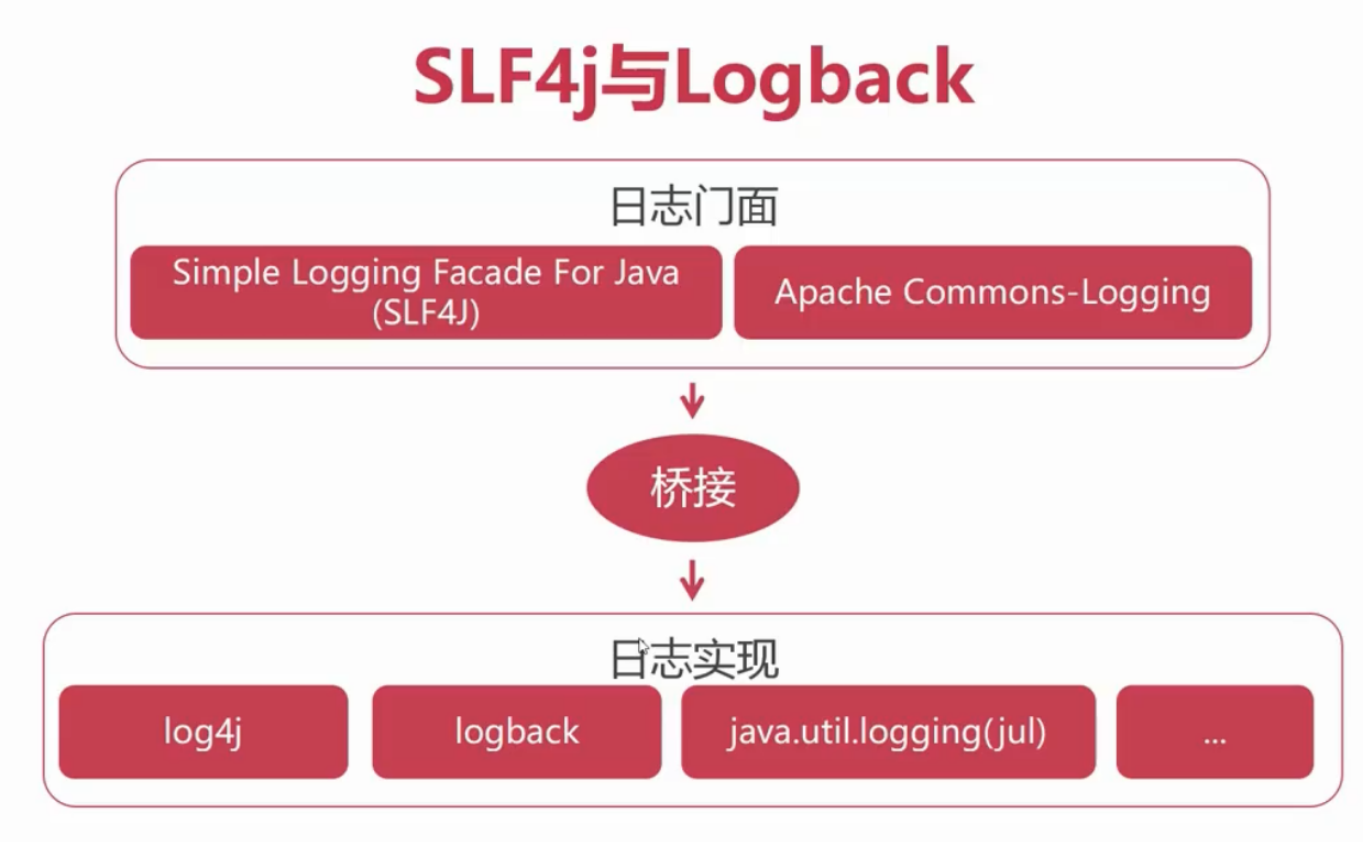
1.2 (logback)日志环境配置
01. pom.xml
<dependency><groupId>ch.qos.logback</groupId><artifactId>logback-classic</artifactId><version>1.2.11</version></dependency>02. 运行测试方法
@Testpublic void testSelectByTitle02() throws Exception{SqlSession sqlSession = null;try{sqlSession = MyBatisUtils.openSession();Map param = new HashMap();param.put("title","'爱恩幼 孕妇护肤品润养颜睡眠面膜 100g'");List<Goods> list = sqlSession.selectList("goods.selectByTitleAndOrder", param);for(Goods goods: list){System.out.println(goods.getSubTitle() + ":" + goods.getDiscount());}}catch (Exception e){throw e;}finally{MyBatisUtils.closeSession(sqlSession);}}
03. 配置logback.xml文件
<!--日志的输出级别:error: 错误 - 系统的故障日志warn: 警告 - 存在风险或使用不当的日志info: 一般性消息 ==》往上常用于 生产环境debug: 程序内部用于调试信息 ==》常用于 调试开发阶段trace: 程序运行的跟踪信息 -->
<?xml version="1.0" encoding="UTF-8" ?>
<configuration><appender name="console" class="ch.qos.logback.core.ConsoleAppender"><encoder><pattern>[%thread] %d{HH:mm:ss:SSS} %-5level %logger{36} - %msg%n</pattern></encoder></appender><!--日志的输出级别:error: 错误 - 系统的故障日志warn: 警告 - 存在风险或使用不当的日志info: 一般性消息 ==》往上常用于 生产环境debug: 程序内部用于调试信息 ==》常用于 调试开发阶段trace: 程序运行的跟踪信息--><root level="debug"><appender-ref ref="console"/></root>
</configuration>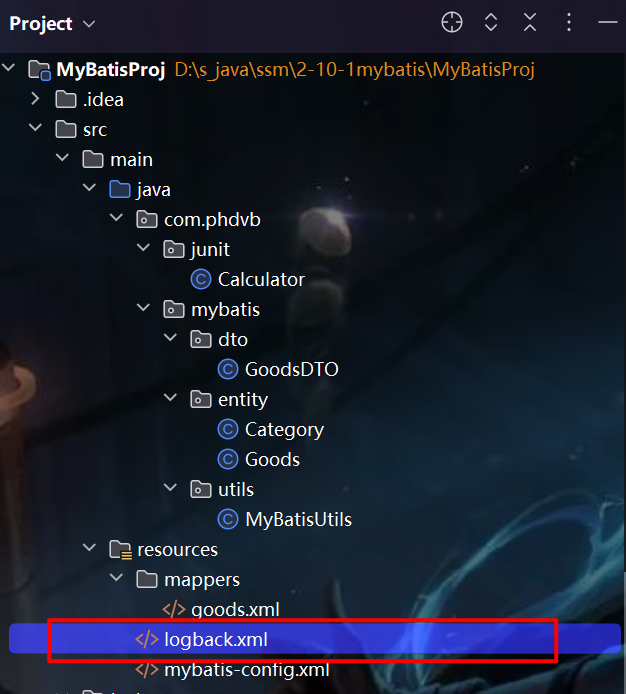
2. 动态SQL的使用
2.1 概述
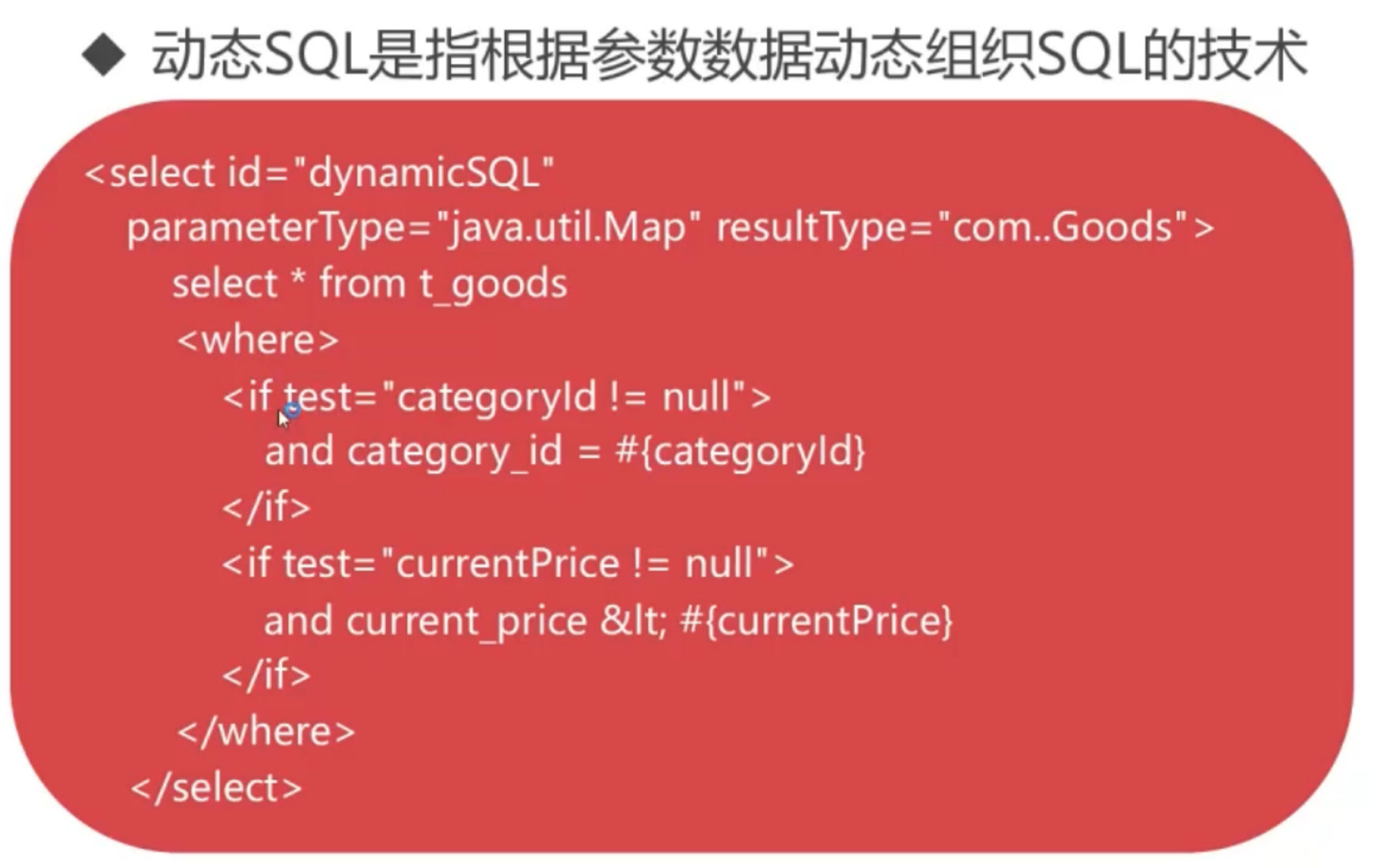
2.2 goods.xml
<!--动态SQL写法01--><select id="dynamicSQL" parameterType="java.util.Map" resultType="com.phdvb.mybatis.entity.Goods">select * from t_goodswhere1=1<if test = "categoryId != null">and categroy_id = #{categoryId}</if><if test = "currentPrice != null">and current_price < #{currentPrice}</if></select><!--动态SQL写法02<where>--><select id="dynamicSQL02" parameterType="java.util.Map" resultType="com.phdvb.mybatis.entity.Goods">select * from t_goods<where><if test = "categoryId != null">and category_id = #{categoryId}</if><if test = "currentPrice != null">and current_price < #{currentPrice}</if></where></select>2.3 testDynamicSQL()
@Testpublic void testDynamicSQL() throws Exception{SqlSession sqlSession = null;try{sqlSession = MyBatisUtils.openSession();Map param = new HashMap();param.put("categoryId", 44);param.put("currentPrice", 500);// 查询条件List<Goods> list = sqlSession.selectList("goods.dynamicSQL02", param);for(Goods goods: list){System.out.println(goods.getTitle() + ":" +goods.getGoodsId() +goods.getCategoryId() + ":" + goods.getCurrentPrice());}}catch (Exception e){throw e;}finally{MyBatisUtils.closeSession(sqlSession);}}2.4 实现效果
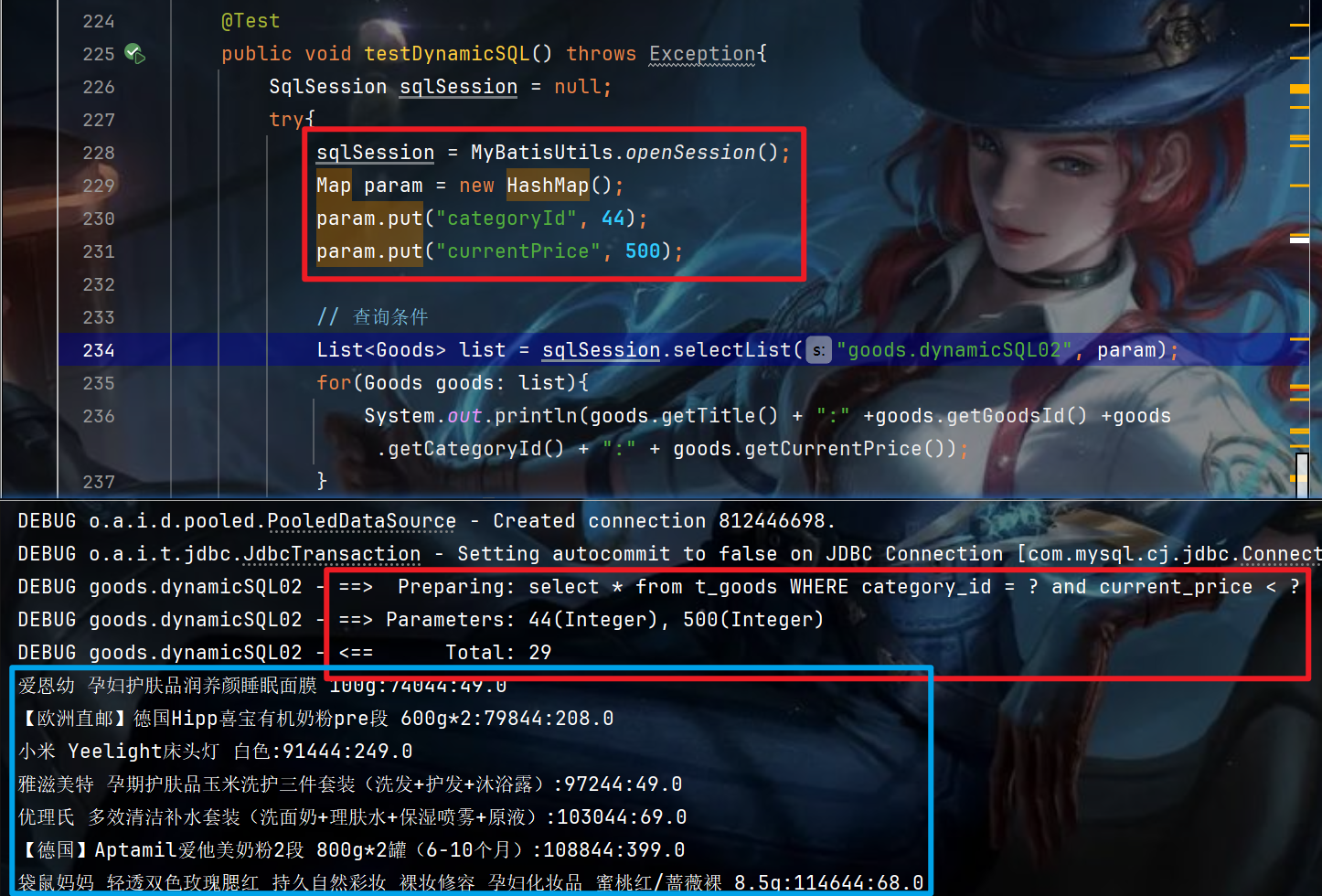
3. MyBatis 二级缓存
3.1 缓存范围 与 运行规则
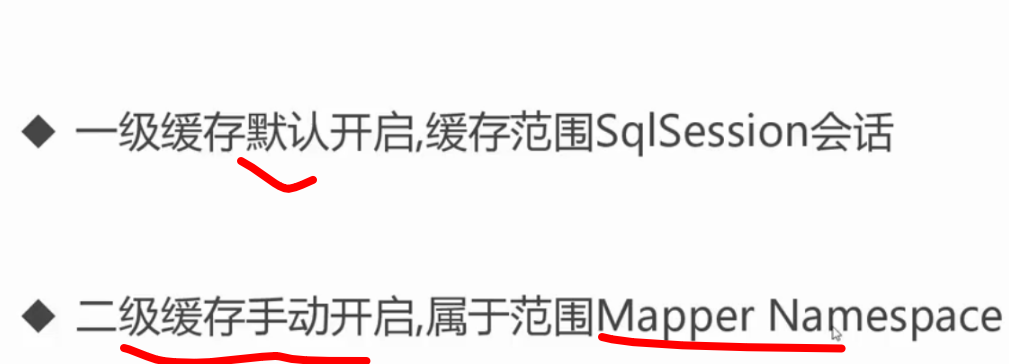
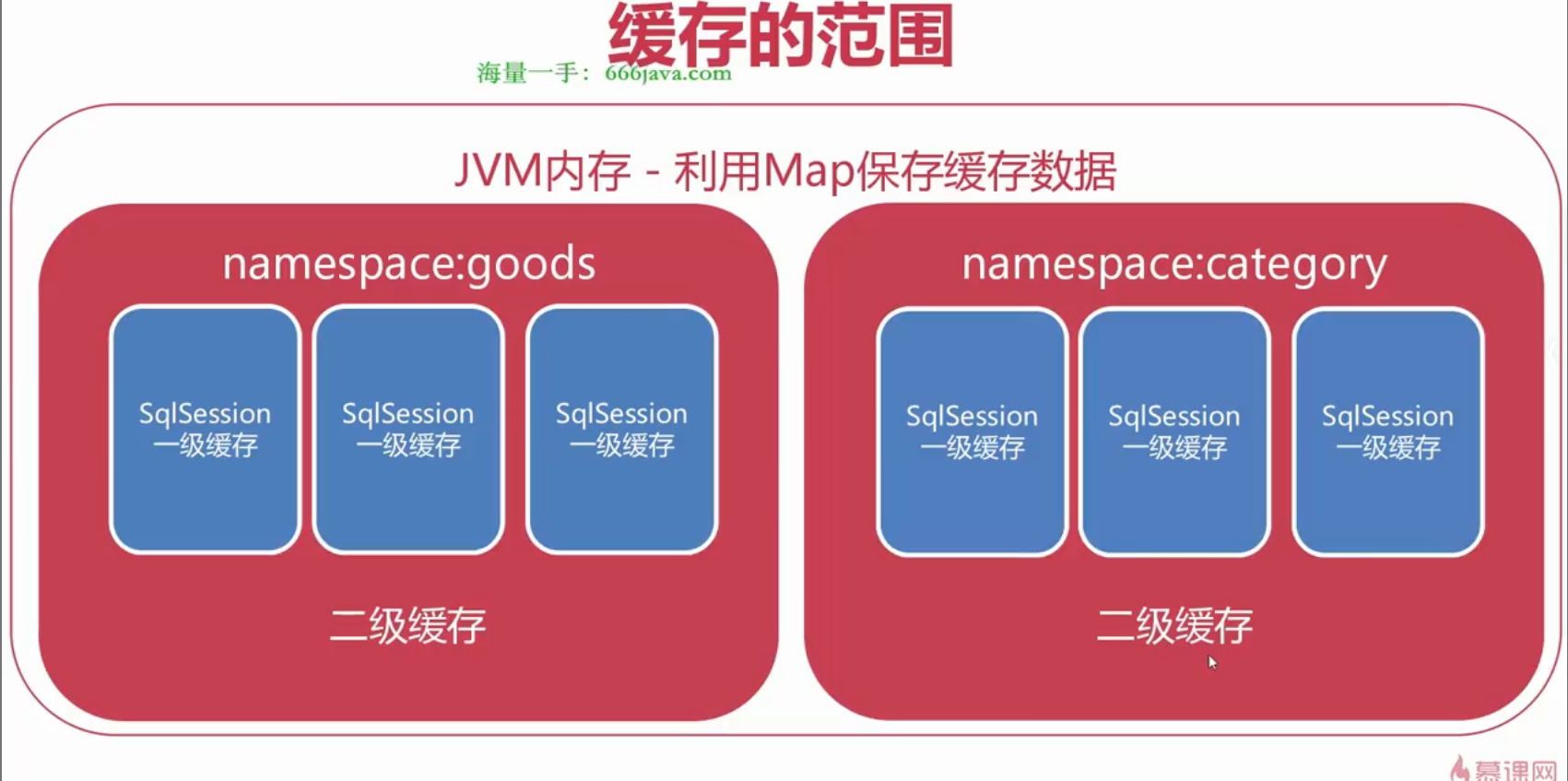
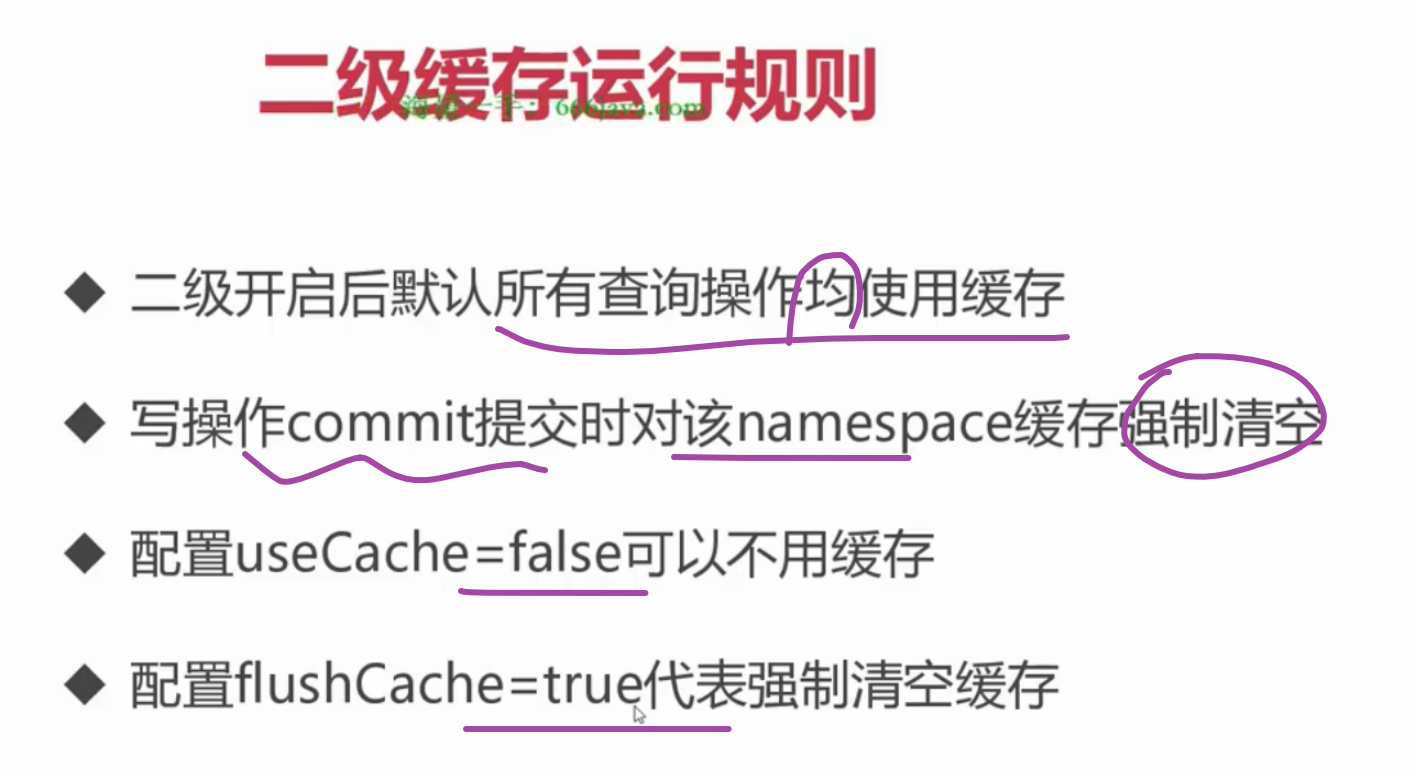
3.2 测试一级缓存
@Testpublic void testLvCache() throws Exception{SqlSession sqlSession = null;try{sqlSession = MyBatisUtils.openSession();Goods goods1 = sqlSession.selectOne("goods.selectById", 831);Goods goods2 = sqlSession.selectOne("goods.selectById", 831);System.out.println(goods1.hashCode() + "-"+ goods2.hashCode());}catch (Exception e){throw e;}finally{MyBatisUtils.closeSession(sqlSession);}}
在同一个会话中,下一次重复的查询会使用重复记录
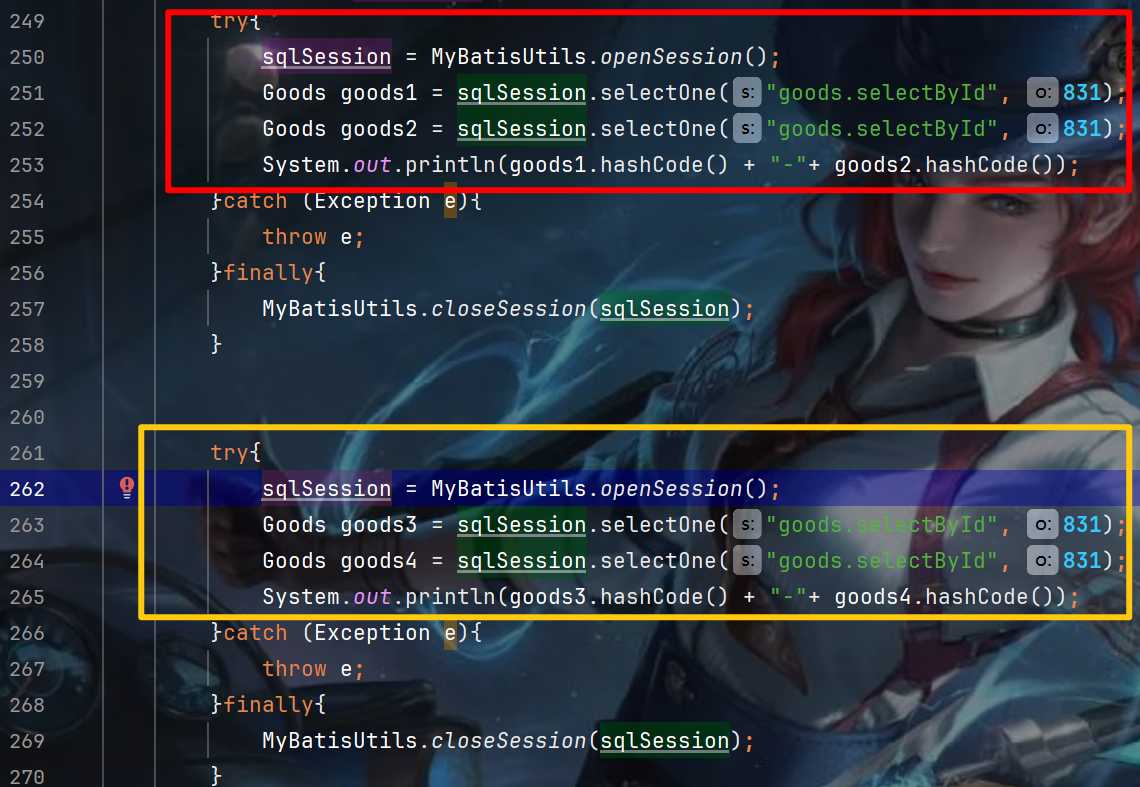
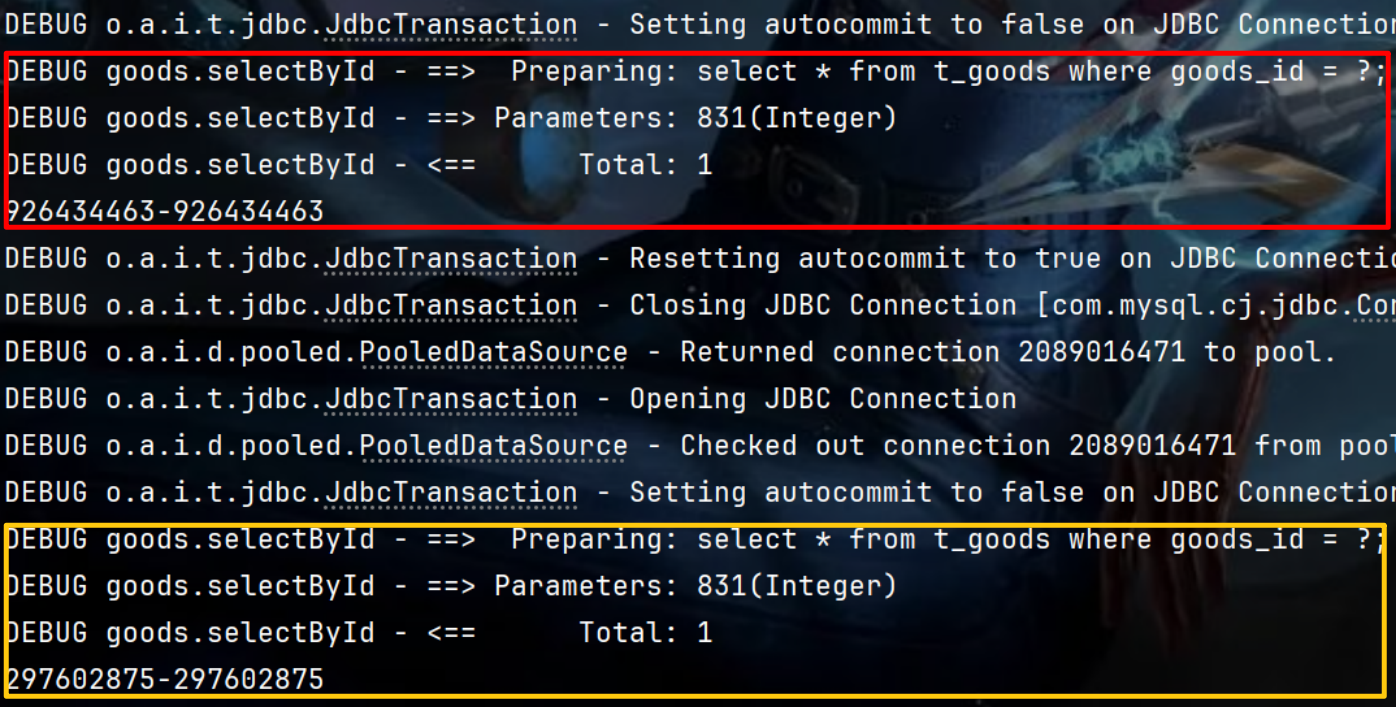
3.3 sqlSession.commit() 强制清空 已有的缓存
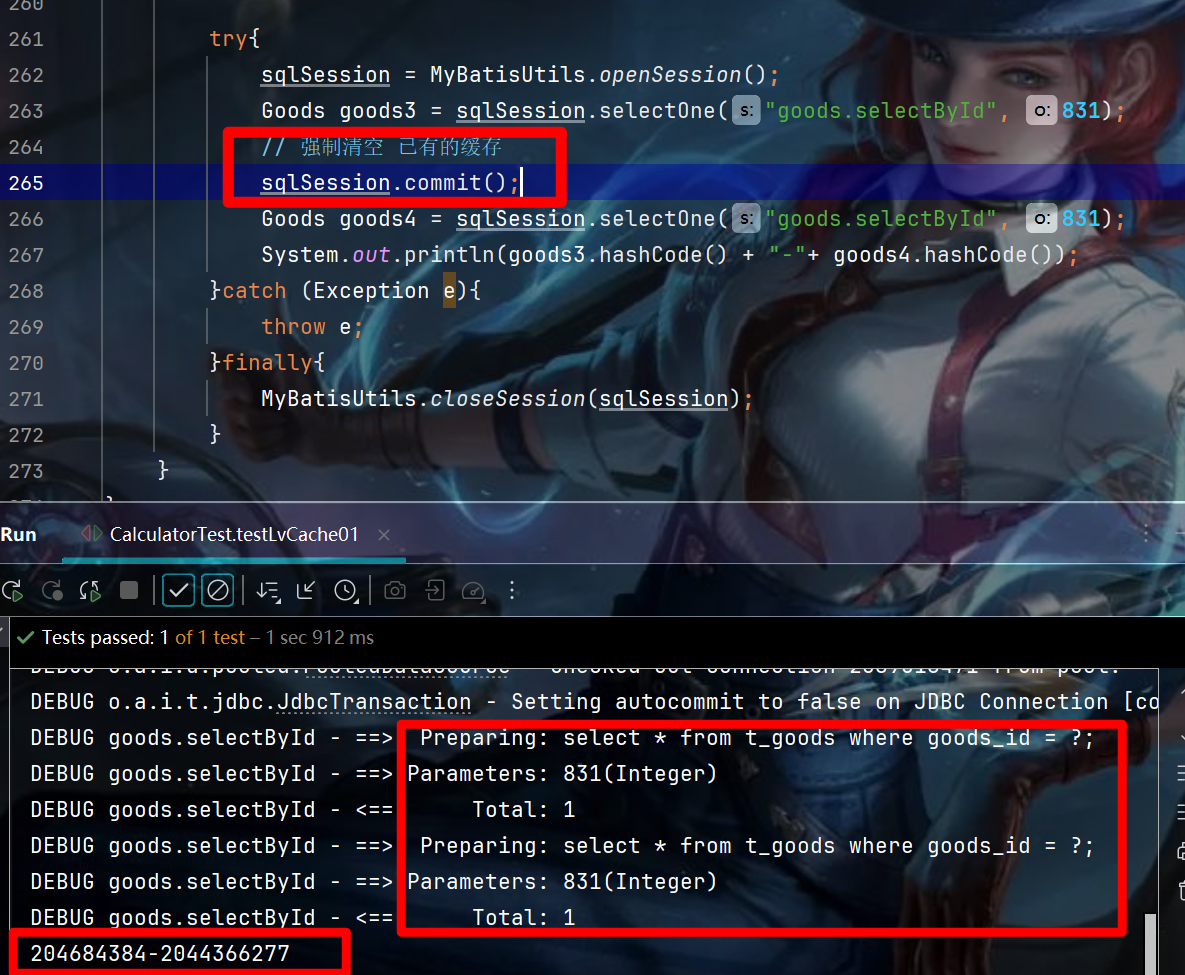
3.4 开启二级缓存

<?xml version="1.0" encoding="UTF-8"?>
<!DOCTYPE mapperPUBLIC "-//mybatis.org//DTD Mapper 3.0//EN""http://mybatis.org/dtd/mybatis-3-mapper.dtd">
<mapper namespace="goods">
<!-- 开启二级缓存--><cache eviction="LRU" flushInterval="600000" size="512" readOnly="true"/>@Testpublic void testLvCache02() throws Exception{SqlSession sqlSession = null;try{sqlSession = MyBatisUtils.openSession();Goods goods1 = sqlSession.selectOne("goods.selectById", 831);System.out.println(goods1.hashCode());}catch (Exception e){throw e;}finally{MyBatisUtils.closeSession(sqlSession);}try{sqlSession = MyBatisUtils.openSession();Goods goods3 = sqlSession.selectOne("goods.selectById", 831);System.out.println(goods3.hashCode());}catch (Exception e){throw e;}finally{MyBatisUtils.closeSession(sqlSession);}}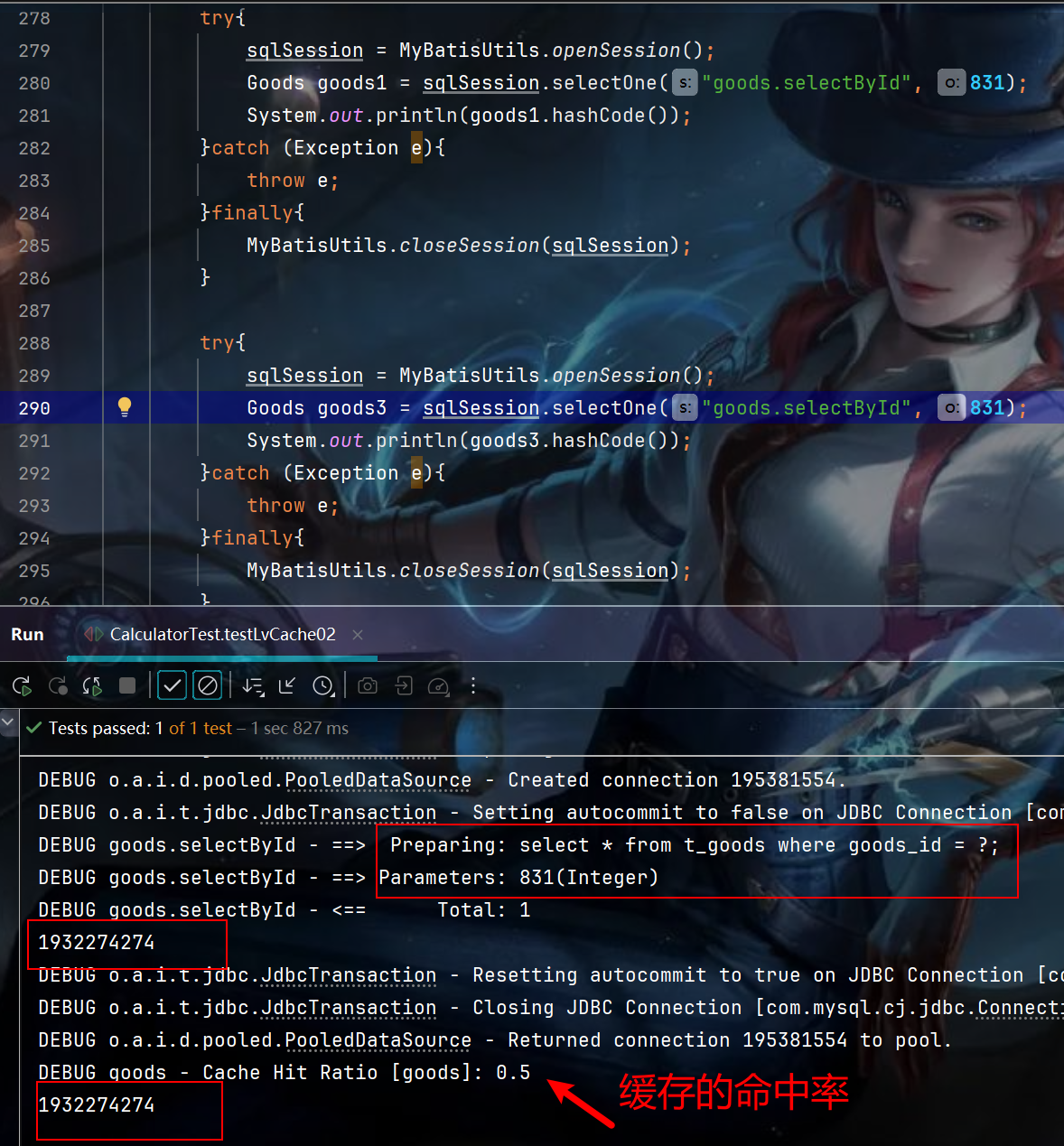
(1)查询标签设置useCache="true"开启缓存:
<!--单参数传递--><select id = "selectById" parameterType="Integer" resultType="com.phdvb.mybatis.entity.Goods" useCache="true">select * from t_goods where goods_id = #{value};</select>(2)插入标签设置flushCache="true"清空缓存
<!--flushCache="true" 在执行sql后强制清空缓存--><insert id="insertGoods"parameterType="com.phdvb.mybatis.entity.Goods"useGeneratedKeys="true"keyProperty="goodsId"keyColumn="goods_id"flushCache="true">insert into t_goods(title, sub_title, original_cost, current_price, discount, is_free_delivery, category_id)values (#{title}, #{subTitle}, #{originalCost}, #{currentPrice}, #{discount}, #{isFreeDelivery}, #{categoryId})</insert>4. 一对多 & 多对一 对象关联查询
4.1 oneToMany 对象关联查询
(1) 创建 GoodsDetail 实体类
package com.phdvb.mybatis.entity;public class GoodsDetail {private Integer gdId;private Integer goodsId;private String gdPicUrl;private Integer gdOrder;private Goods goods;public Integer getGdId() {return gdId;}public void setGdId(Integer gdId) {this.gdId = gdId;}public Integer getGoodsId() {return goodsId;}public void setGoodsId(Integer goodsId) {this.goodsId = goodsId;}public String getGdPicUrl() {return gdPicUrl;}public void setGdPicUrl(String gdPicUrl) {this.gdPicUrl = gdPicUrl;}public Integer getGdOrder() {return gdOrder;}public void setGdOrder(Integer gdOrder) {this.gdOrder = gdOrder;}public Goods getGoods() {return goods;}public void setGoods(Goods goods) {this.goods = goods;}
}
(2)goods新增 List<GoodsDetail> 结果集
public class Goods {private Integer goodsId; // 商品编号private String title; // 商品标题private String subTitle; // 子标题private Float originalCost; // 原始价格private Float currentPrice; // 当前价格private Float discount; // 折扣率private Integer isFreeDelivery; // 是否包邮(1-包邮, 0- 不包邮)private Integer categoryId; // 分类编号private List<GoodsDetail> goodsDetailList;(3)编写 goods_detail.xml 的 selectGoodsDetailByGoodsId 查询标签
<?xml version="1.0" encoding="UTF-8"?>
<!DOCTYPE mapperPUBLIC "-//mybatis.org//DTD Mapper 3.0//EN""http://mybatis.org/dtd/mybatis-3-mapper.dtd">
<mapper namespace="goodsDetail"><select id = "selectGoodsDetailByGoodsId" parameterType="Integer" resultType= "com.phdvb.mybatis.entity.GoodsDetail">select * from t_goods_detail where goods_id = #{value}</select></mapper>(4) mybatis-config.xml 中添加配置
<mappers><mapper resource="mappers/goods.xml"/><mapper resource="mappers/goods_detail.xml"/></mappers>
</configuration>(4) 编写 goods.xml 的 rmGoodsOneToMany结果集
<!-- 一对多 与 多对一 对象关联查询--><!--resultMap 可用于说明 一对多 或者 多对一 的映射逻辑id 是属性应用标志 | type 指向One 的实体(Goods)--><resultMap id="rmGoodsOneToMany" type="com.phdvb.mybatis.entity.Goods"><!-- 映射goods 对象的主键到 goods_id --><id column = "goods_id" property = "goodsId"></id><!--collection 的含义是1. 在 selectOneToMany 查询到结果后,2. 对所有的 Goods 对象遍历得到 goods_id 字段3. 将其带入到selectGoodsDetailByGoodsId 中查询将得到的“商品详情” 集合赋值给goodsDetails List对象--><collection property="goodsDetailList" select = "goodsDetail.selectGoodsDetailByGoodsId"column="goods_id"/></resultMap>(5)编写 selectOneTo(Many 查询标签
<select id = "selectOneToMany" resultMap = "rmGoodsOneToMany">select * from t_goods limit 0, 2</select>(6) 编写 testOneToMany() 测试方法
/*** 一对多对象 关联查询*/@Testpublic void testOneToMany() throws Exception{SqlSession sqlSession = null;try{sqlSession = MyBatisUtils.openSession();List<Goods> list = sqlSession.selectList("goods.selectOneToMany");for(Goods goods: list){System.out.println(goods.getTitle() + ":" + goods.getGoodsDetailList().size());}}catch(Exception e){throw e;}finally{MyBatisUtils.closeSession(sqlSession);}}(7)debug 效果

4.2 ManyToOne 对象关联查询
(1) 编写 goods_detail.xml 的结果集 rmGoodsDetailManyToOne
<resultMap id="rmGoodsDetailManyToOne" type="com.phdvb.mybatis.entity.GoodsDetail">
<!-- <id column = "gd_id" property="gdId"></id>--><result column = "goods_id" property = "goodsId"></result><association property="goods" select ="goods.selectById" column = "goods_id"/></resultMap>(2)编写多对一 查询selectManyToOne 标签
<select id = "selectManyToOne" resultMap="rmGoodsDetailManyToOne">select * from t_goods_detail limit 0, 20</select>(3)编写测试类 testManyToOne()
/*** 多对一 关联查询*/@Testpublic void testManyToOne() throws Exception{SqlSession sqlSession = null;try{sqlSession = MyBatisUtils.openSession();List<GoodsDetail> list = sqlSession.selectList("goodsDetail.selectManyToOne");for(GoodsDetail goodsDetail: list){System.out.println(goodsDetail.getGdId() + ":" +goodsDetail.getGoodsId()+ ":" + goodsDetail.getGdPicUrl() + goodsDetail.getGoods().getSubTitle());}}catch(Exception e){throw e;}finally{MyBatisUtils.closeSession(sqlSession);}}(4)debug 效果
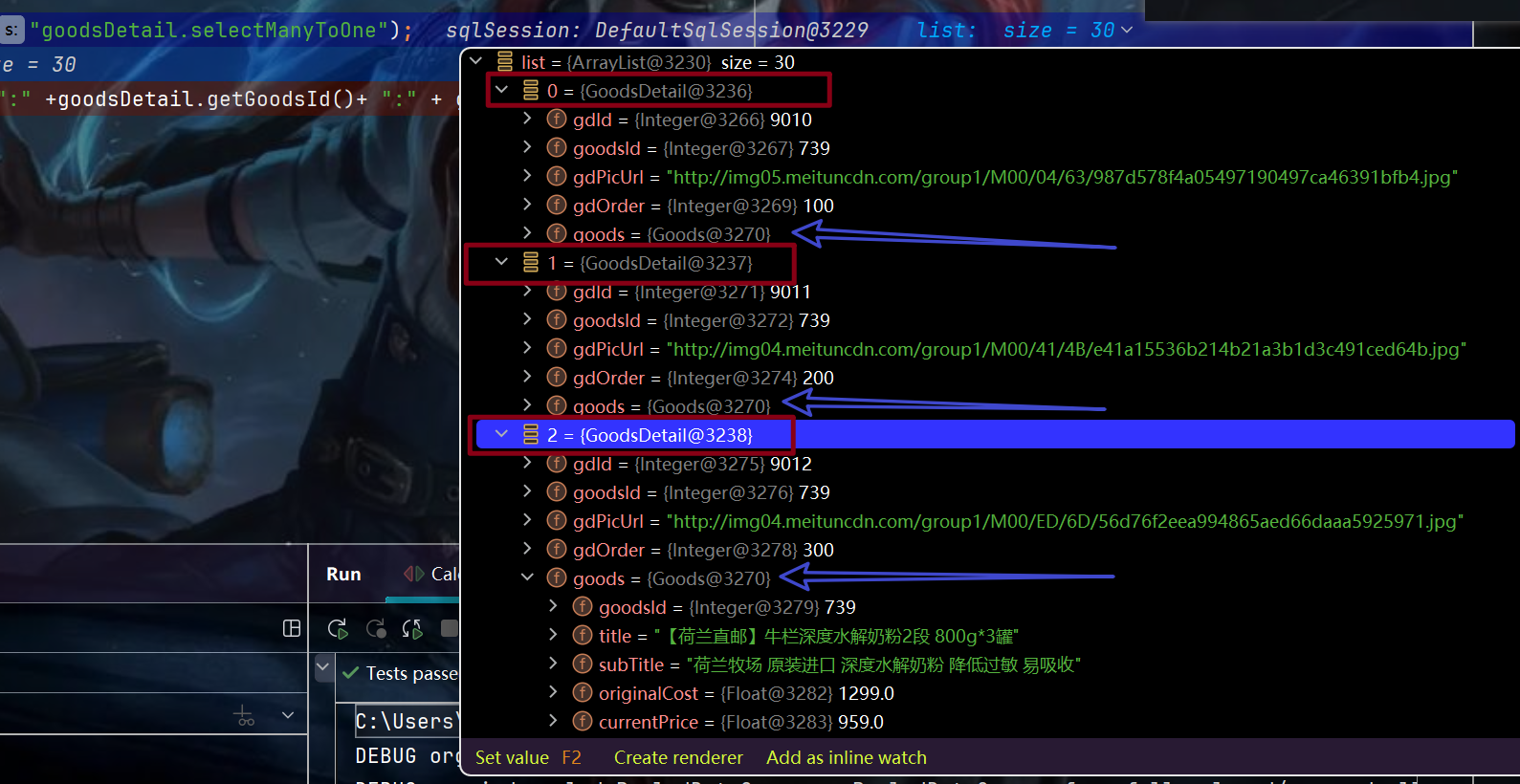
5. 分页查询插件PageHelper
5.0 base
(1) 分页查询的麻烦事
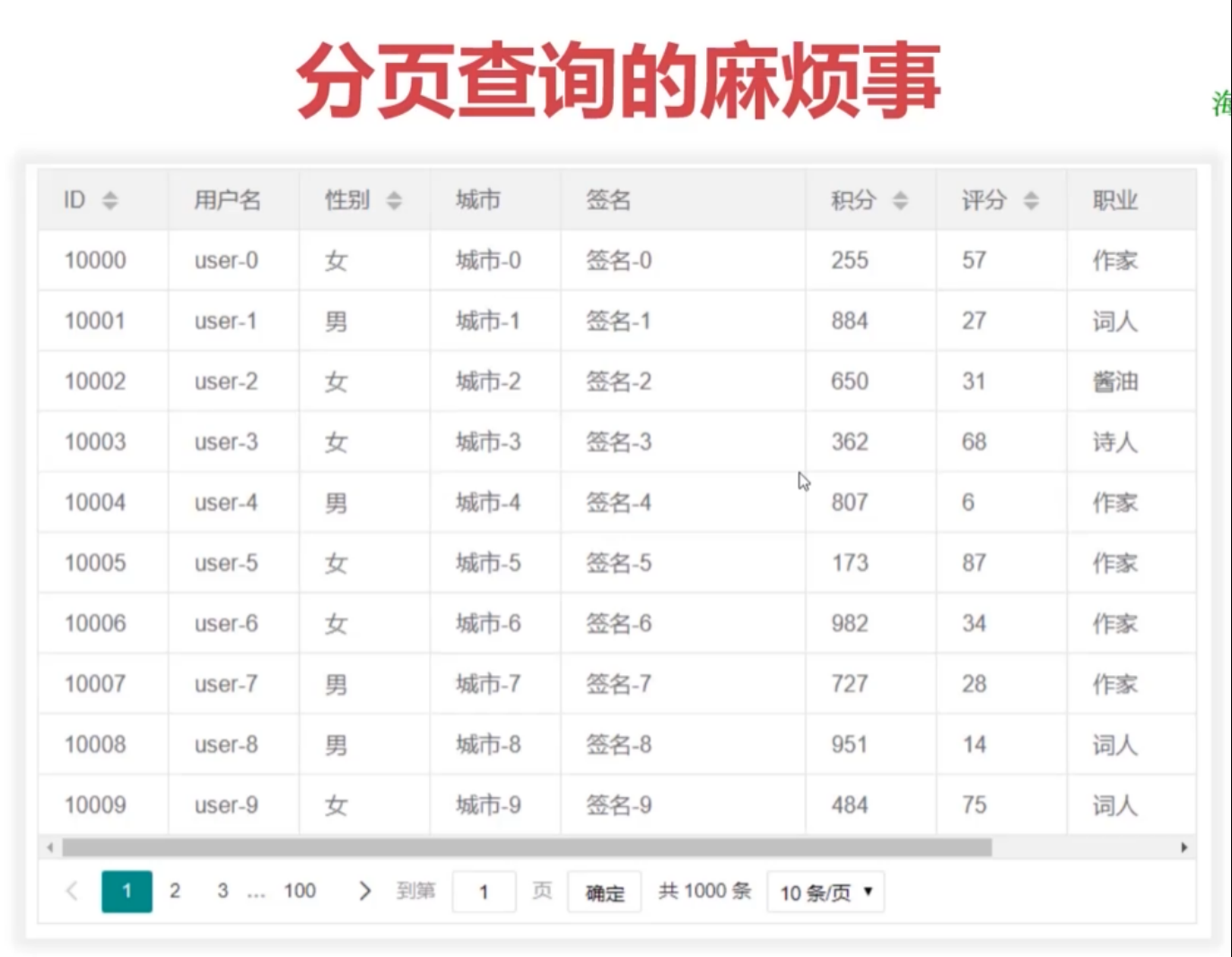
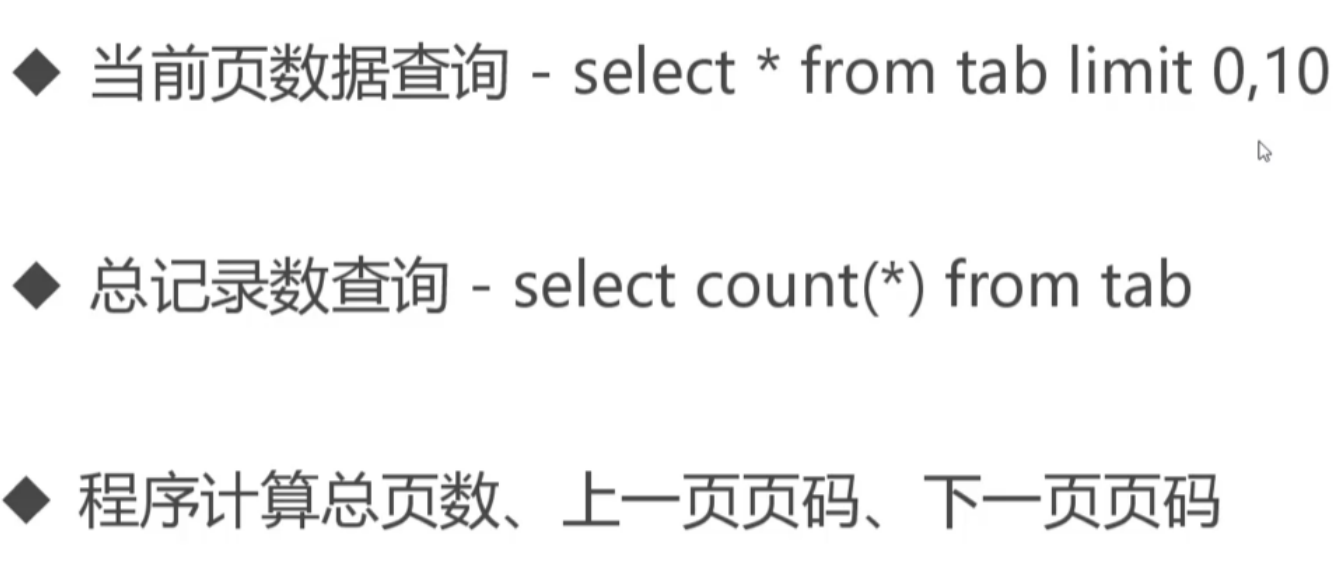
5.1 PageHelper
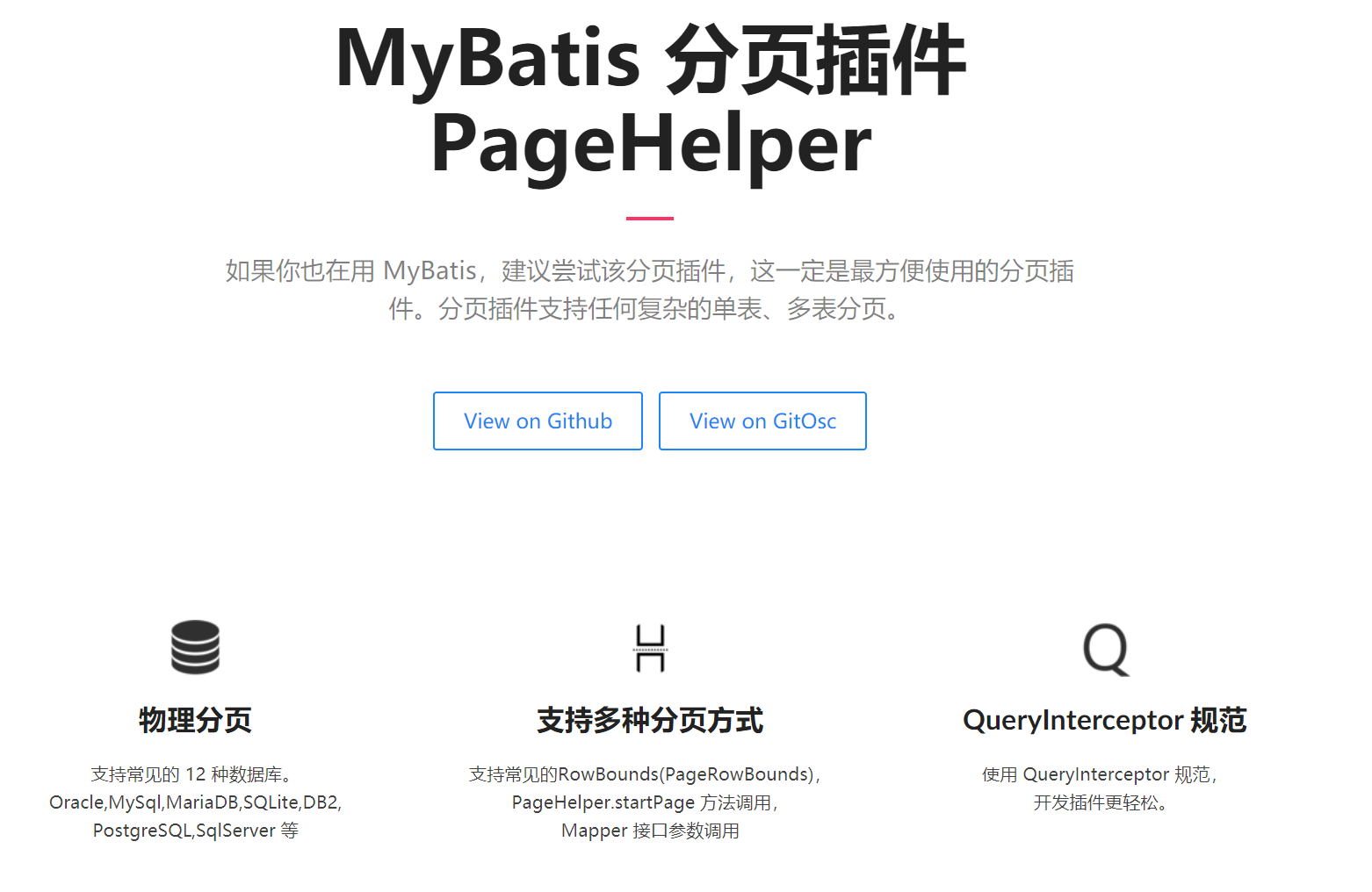
官方链接:
MyBatis 分页插件 PageHelper
如何使用分页插件doc:
如何使用分页插件
5.2 pageHelper 使用流程
(1) 引入依赖
<dependency><groupId>com.github.pagehelper</groupId><artifactId>pagehelper</artifactId><version>5.1.8</version>
</dependency><!--sql 解析器-->
<dependency><groupId>com.github.jsqlparser</groupId><artifactId>jsqlparser</artifactId><version>2.0</version>
</dependency>(2)mybatis-config.xml 中增 Pagehelper 配置
<!--启用 Pagehelper 分页插件--><plugins><plugin interceptor="com.github.pagehelper.PageInterceptor"><!--设置数据库类型--><property name="helperDialect" value="mysql"/><!--设置分页合理化--><property name="reasonable" value="true"/></plugin></plugins>(3)goods.xml 中添加分页查询标签
<!--将价格小于800的商品分页查询出来-->
<select id="selectPage" resultMap="com.phdvb.mybatis.entity.Goods">select * from t_goods where current_price < 800
</select>(4) 编写测试方法 testSelectPage()
/*** PageHelper 分页查询*/@Testpublic void testSelectPage() throws Exception{SqlSession sqlSession = null;try{sqlSession = MyBatisUtils.openSession();/*startPage 方法会自动将 下一次查询进行分页*/PageHelper.startPage(3,15);Page<Goods> page = (Page) sqlSession.selectList("goods.selectPage");System.out.println("总页数:" + page.getPages()); //总页数:119System.out.println("总记录数:" + page.getTotal()); //总记录数:1774System.out.println("开始行号:" + page.getStartRow()); //开始行号:30System.out.println("结束行号:" + page.getEndRow()); //结束行号:45System.out.println("当前页码:" + page.getPageNum()); //当前页码:3List<Goods> list = page.getResult();for (Goods good : list) {System.out.println(good.getGoodsId() +"-"+ good.getSubTitle());}System.out.println();}catch (Exception e){throw e;}finally{MyBatisUtils.closeSession(sqlSession);}}(5) 封装实现

(6) 实现效果
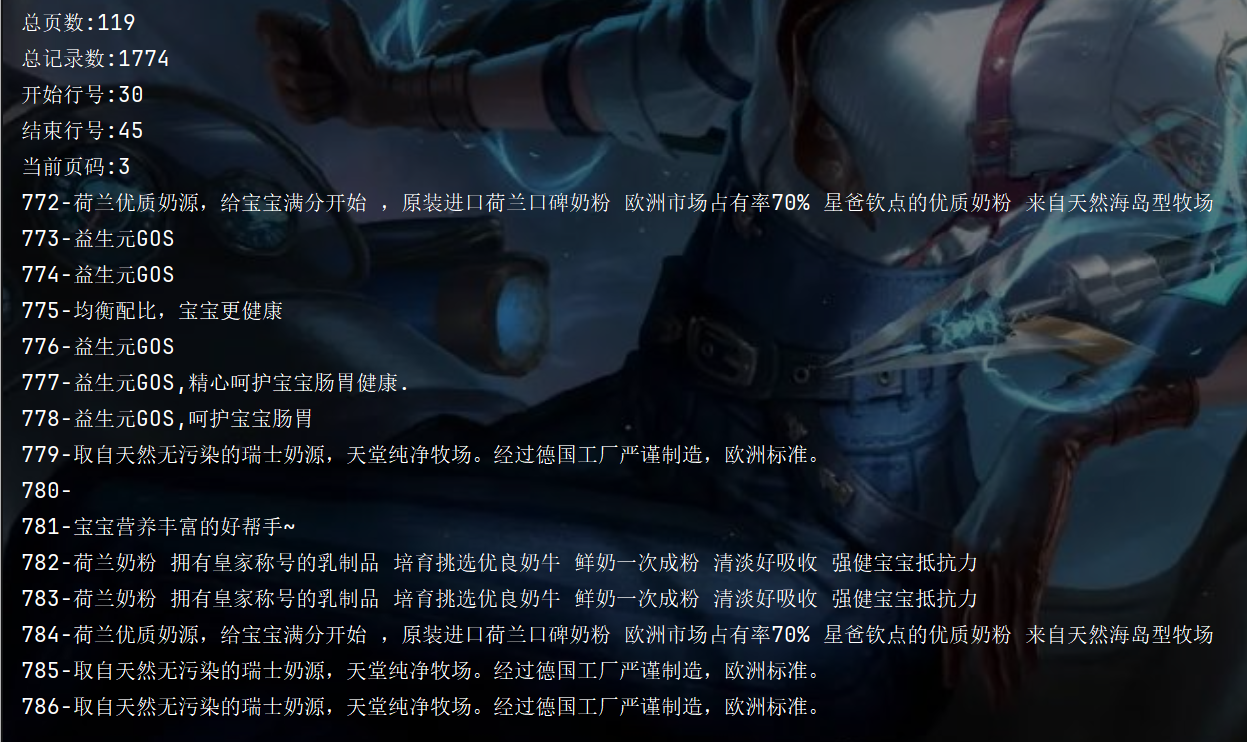
6.Mybatis 配置 C3P0 连接池
6.1 引入 c3p0 依赖
<dependency><groupId>com.mchange</groupId><artifactId>c3p0</artifactId><version>0.9.5.4</version>
</dependency>6.2 创建C3P0 与 Mybatis 兼容使用的数据源工厂类
package com.phdvb.mybatis.datasource;import com.mchange.v2.c3p0.ComboPooledDataSource;
import org.apache.ibatis.datasource.unpooled.UnpooledDataSourceFactory;/*** C3P0 与 Mybatis 兼容使用的数据源工厂类*/
public class C3P0DataSourceFactory extends UnpooledDataSourceFactory {public C3P0DataSourceFactory() {this.dataSource = new ComboPooledDataSource();}
}
6.3 mybatis-config.xml 中配置C3P0 的相关连接信息
<environment id="prod"><!-- 采用JDBC的方式对 数据库事务进行 commit/ rollback--><transactionManager type="JDBC"></transactionManager><!-- 采用连接池的方式管理数据库连接-->
<!-- <dataSource type="POOLED">-->
<!-- <property name="driver" value="com.mysql.jdbc.Driver"/>-->
<!-- <property name="url" value="jdbc:mysql://114.114.114.114:3303/phdvb?useSSL=false&useUnicode=true&characterEncoding=UTF-8&serverTimezone=Asia/Shanghai"/>-->
<!-- <property name="username" value="root"/>-->
<!-- <property name="password" value="123456"/>-->
<!-- </dataSource>--><!--采用 C3P0 连接池的方式管理数据库连接--><dataSource type="com.phdvb.mybatis.datasource.C3P0DataSourceFactory"><property name="driverClass" value="com.mysql.jdbc.Driver"/><property name="jdbcUrl" value="jdbc:mysql://114.114.114.114:3303/phdvb?useSSL=false&useUnicode=true&characterEncoding=UTF-8&serverTimezone=Asia/Shanghai"/><property name="user" value="root"/><property name="password" value="123456"/><property name="initialPoolSize" value="5"/><property name="maxPoolSize" value="20"/><property name="minPoolSize" value="5"/></dataSource></environment>7. Mybatis 批处理 SQL
Q1:
batchInsert 无法获取新增数据的 Id
Q2:
批量生成的SQL太长,可能会被服务器拒绝
7.1 批量插入
(1)编写SQL标签
<!--批处理SQL 一次插入多条SQL-->
<!-- insert into table values ("a", "a1", "a2"), ("b", "b1", "b2"),(...)--><insert id="batchInsert" parameterType="java.util.List">insert into t_goods(title, sub_title, original_cost, current_price, discount, is_free_delivery, category_id)values<foreach collection="list" item = "item" index="index" separator=",">(#{item.title},#{item.subTitle},#{item.originalCost},#{item.currentPrice},#{item.discount},#{item.isFreeDelivery},#{item.categoryId},)</foreach></insert>(2) 编写测试类
@Testpublic void testBatchInsert() throws Exception{SqlSession session = null;try{long st = new Date().getTime();session = MyBatisUtils.openSession();List list = new ArrayList();for (int i = 0; i < 10000; i++ ){ //执行时间:3160毫秒
// for (int i = 0; i < 2; i++ ){ //执行时间:1970毫秒Goods goods = new Goods();goods.setTitle("测试商品"+ "i");goods.setSubTitle("测试子标题"+ "i");goods.setOriginalCost(300f + i);goods.setCurrentPrice(500f + i);goods.setDiscount(i * 0.0001f);goods.setIsFreeDelivery(1);goods.setCategoryId(43);list.add(goods);}session.insert("goods.batchInsert", list);session.commit(); // 提交事务long et = new Date().getTime();System.out.println("执行时间:" + (et - st) + "毫秒") ;}catch(Exception e){throw e;}finally{MyBatisUtils.closeSession(session);}}7.2 批量删除
(1) 编写SQL标签
<!--批处理SQL 一次性删除多条SQL--><delete id="batchDelete" parameterType="java.util.List">delete from t_goods where goods_id in<foreach collection="list" item="item" index="index" open="(" close=")" separator=",">#{item}</foreach></delete>(2)测试方法 testBatchDelete
@Testpublic void testBatchDelete() throws Exception{SqlSession session = null;try{long st = new Date().getTime();session = MyBatisUtils.openSession();List list = new ArrayList();list.add(12685);list.add(12684);list.add(12683);list.add(12682);list.add(12681);session.delete("goods.batchDelete", list);session.commit();long et = new Date().getTime();System.out.println("执行时间:" + (et - st) + "毫秒") ;}catch(Exception e){throw e;}finally{MyBatisUtils.closeSession(session);}}8. MyBatis 注解开发
将xml代码放入程序中,开发更加方便
8.1 MyBatis 的常用注解
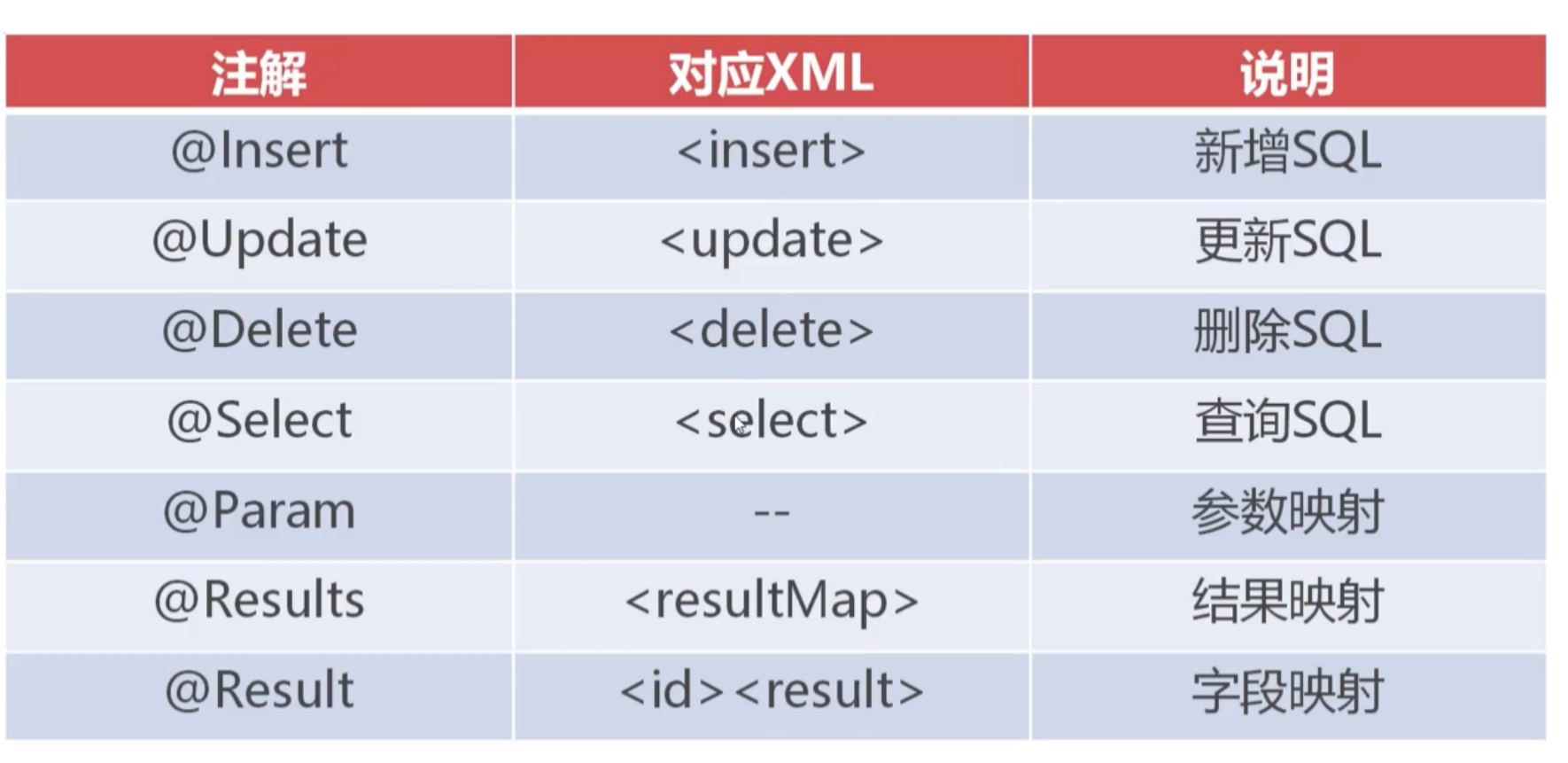
8.2 @Select
(1) 注释掉 mapper 标签

(2) 编写 GoodsDTO1
package com.phdvb.mybatis.dto;public class GoodsDTO1 {private Integer goodsId;private String title;private Float currentPrice;public GoodsDTO1() {}public Integer getGoodsId() {return goodsId;}public void setGoodsId(Integer goodsId) {this.goodsId = goodsId;}public String getTitle() {return title;}public void setTitle(String title) {this.title = title;}public Float getCurrentPrice() {return currentPrice;}public void setCurrentPrice(Float currentPrice) {this.currentPrice = currentPrice;}
}(3) 编写 GoodsDAO 接口
package com.phdvb.mybatis.dao;import com.phdvb.mybatis.entity.Goods;
import org.apache.ibatis.annotations.Param;
import org.apache.ibatis.annotations.Select;import java.util.List;public interface GoodsDAO {@Select(" select * from t_goods where current_price between #{min} and #{max} limit 0, #{limt}")public List<Goods> selectByPriceRange(@Param("min") Float min, @Param("max") Float max, @Param("limt") Integer limt);
}
(4)调整 mybatis-config.xml
<!--注解开发时。可以不写 ~.xml--><mappers>
<!-- <mapper resource="mappers/goods.xml"/>--><!--注解开发写法一-->
<!-- <mapper class = "com.phdvb.mybatis.dao.GoodsDAO"/>--><!--注解开发写法二--><package name="com.phdvb.mybatis.dao"/></mappers>(5) 测试 @Select 注解
// 测试 @Select 注解@Testpublic void testAnnotationSelectRange() throws Exception{SqlSession sqlSession = null;try{sqlSession = MyBatisUtils.openSession();GoodsDAO goodsDAO = sqlSession.getMapper(GoodsDAO.class);List<Goods> list = goodsDAO.selectByPriceRange(100f, 500f, 20);System.out.println(list.size());}catch (Exception e){throw e;}finally{MyBatisUtils.closeSession(sqlSession);}}8.3 @Insert
(1)编写接口
@Insert("insert into t_goods(title, sub_title, original_cost, current_price, discount, is_free_delivery, category_id) values (#{title}, #{subTitle}, #{originalCost}, #{currentPrice}, #{discount}, #{isFreeDelivery}, #{categoryId})")// 之前使用 <selectKey> 获取id@SelectKey(statement = "select last_insert_id()", before = false, keyProperty = "goodsId", resultType = Integer.class)public int insert(Goods goods);(2)编写测试类
// 测试 @Insert 注解@Testpublic void testInsert() throws Exception{SqlSession sqlSession = null;try{sqlSession = MyBatisUtils.openSession();Goods goods = new Goods();goods.setTitle("测试Insert goods");goods.setSubTitle("测试Insert Sub goods");goods.setOriginalCost(200f);goods.setCurrentPrice(100f);goods.setDiscount(0.55f);goods.setIsFreeDelivery(1);goods.setCategoryId(43);GoodsDAO goodsDAO = sqlSession.getMapper(GoodsDAO.class);int num = goodsDAO.insert(goods);sqlSession.commit();System.out.println(goods.getGoodsId());}catch (Exception e){if(sqlSession != null){sqlSession.rollback();}}finally{MyBatisUtils.closeSession(sqlSession);}}(3)测试testSelectAll()
@Testpublic void testSelectAll() throws Exception{SqlSession sqlSession = null;try{sqlSession = MyBatisUtils.openSession();GoodsDAO goodsDAO = sqlSession.getMapper(GoodsDAO.class);List<GoodsDTO1> list = goodsDAO.selectAll();System.out.println(list.size()); //11936}catch (Exception e){throw e;}finally {MyBatisUtils.closeSession(sqlSession);}}